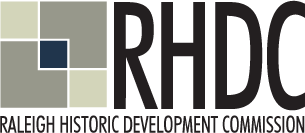The mission of the Raleigh Historic Development Commission is to identify, preserve, protect, and promote Raleigh’s historic resources.
Our Mission
Historic Districts
Designation of historic neighborhoods or communities as local historic districts is a successful tool for maintaining quality of life and providing economic security. Preservation has been proven to stabilize property values and stimulate new investment in older neighborhoods.
A Raleigh Historic District is a distinctive area, a place of singular historical flavor characterized by its streets and squares, buildings and trees, architectural design and landscape features. It may be monumental or simple, residential or commercial. There are currently six local historic districts in Raleigh: Blount Street, Boylan Heights, Capitol Square, Moore Square, Oakwood, and Prince Hall.
RHDC is charged by the City Council to consider local historic district designation where appropriate. The City's 2030 Comprehensive Plan recommends the consideration of historic overlay district zoning for the Depot and Fayetteville Street historic districts.
Historic District Overlay Zoning
Celebrating Raleigh's past is an invaluable tool for designing its future. In 1961 the City Council resolved to appoint a committee to evaluate the preservation of its historical antiquities, which over time has evolved into the Raleigh Historic Development Commission (RHDC). The City, guided by the RHDC, has designated six local historic districts with the specific intention of preserving the existing character found in Raleigh's historic neighborhoods.
The establishment of local historic district overlay zoning is allowed by state statute (NCGS Chapter 160A, Article 19, Part 3C) and is found in the city's Municipal Code §10-2052. The process of designating an historic district through historic district overlay zoning begins when a neighborhood organization, a preservation group, or the city proposes a specific area or neighborhood as a valuable historic resource. At this time the city begins an open, step-by-step local historic district designation process during which public comment is critical. By law, property owners in a potential district must be notified of the zoning proposal so that they may appear and comment on it during the public hearings. Following careful research and consideration the City Council may pass an ordinance designating a local historic district.
Following designation, properties located within local historic districts are subject to an architectural and landscape design review process administered by the RHDC. Design guidelines guide property owners or stewards in modifying historic district properties while retaining historic character, resulting in the issuance of a RDHC Certificate of Appropriateness (COA).
As of 2013, the City recognizes six local historic districts: Blount Street, Boylan Heights, Capitol Square, Moore Square, Oakwood, and Prince Hall. These districts represent residential neighborhoods, downtown commercial and industrial districts, and an institutional district that has adapted former residential buildings for current institutional purposes. It is anticipated that additional Raleigh neighborhoods will seek designation as local historic districts.
Please email us for more information.
Designation Process
A local historic district designation request may be generated by the community or RHDC. Generally, a local historic district nomination is submitted to staff, reviewed by the RHDC, and sent to the NC State Historic Preservation Office for initial review. Factors considered are historic, cultural, architectural, neighborhood, and/or community significance. The next stage of the process includes a public review of the nomination, which includes press release, notification to property owners within and adjacent to the district, and public meetings. Upon completion of community review, RHDC may recommend the nomination to City Council for consideration and potential designation.
